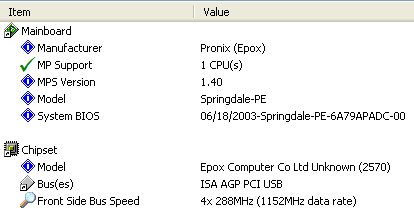System setup and notes
Here's a quick rundown of the test system should you wish to compare benchmark results with your own.- Intel Pentium 4 3.2GHz 800FSB CPU
- AMD Barton XP3200+ S462 CPU (2200MHz / 200FSB)
- EPoX 4PDA2+ i865PE Springdale
- DFI LANPARTY PRO875 i875P Canterwood
- EPoX 8KRA2+ KT600
- Shuttle SN45G XPC SFF Cube (nForce2 Ultra 400)
Other components
- ATi Radeon 9700 Pro (324/310)
- 2 x 256MB Corsair XMS3500C2, run at 2-6-2-2 @ DDR-400 for the
Software
- Windows XP Professional Build 2600.xpclient.010817-1148
- DirectX9
Notes
Two Intel and two AMD chipsets will fight it out to be crowned the performance champion of our select little group. The 4PDA2+ would sometimes take a while to boot from a cold start. That problem, however, seemed to be alleviated somewhat with a flash to the 6/18 BIOS. As mentioned before, the bundle shipped without a driver CD but obtaining the drivers via another PC connected to the net proved to be as simple as a Google search.
Stability was good. The combination of a stable OS and mature chipset manufacturing process should usually allow for top-notch stability. The board had no problems in running our standard 2-6-2-2 memory timings. Adding a further two Corsair XMS3500 C2 modules resulted in a slight relaxation to 2-7-2-3 (tRAS=3).
Once again, explicitly stating clock speeds should inform us whether certain manufacturers are gaining an artificial benchmark lead.
3222.6MHz / 201.4FSB - EPoX 4PDA2+
3208.1MHz / 200.5FSB - DFI LANPARTY PRO875
2205.21MHz / 200.47FSB - Shuttle SN45G nForce2 (AMD)
2205.2 / 200.47FSB - VIA KT600 (AMD)
The EPoX steals around 15MHz on the DFI Canterwood board. ~ 0.5% clock speed difference is enough to make two boards based on one chipset appear statistically different. We're benchmarking four different chipsets so that is less of an issue. We'd wish that manufacturers would have some form of FSB consistency. A quick note about the comparison KT600. Our sample featured an initial BIOS that wasn't geared towards pure performance. We expect its numbers to improve with subsequent BIOS releases.
Lastly, a switch to a 3.2GHz CPU and a Radeon 9800 Pro's death means that previous boards' results cannot be compared to the results obtained here. An ATi Radeon 9700 Pro takes up position in the AGP slot.
FSB overclocking went better than expected. We normally expect at least 250FSB from each and every i865 / i875 board. Anything above this can be considered a bonus. The 4PDA2+ managed our basic 250FSB with ease. 275FSB came and went.

290+ FSB was semi-flakey but we can't complain at 288FSB with utter stability. Well above average, we'd say.









